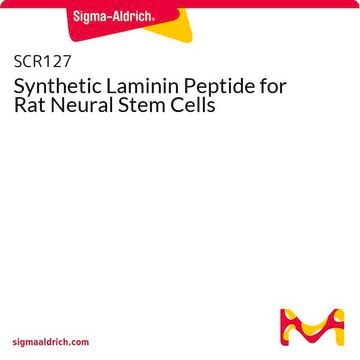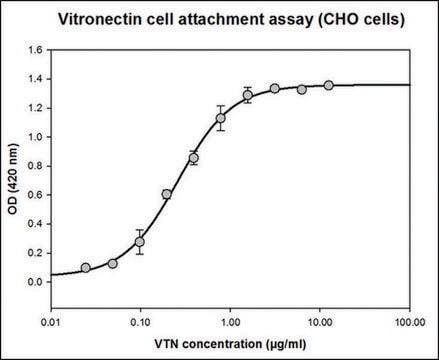L4544
Human Laminin
from human fibroblasts, cell culture derived, liquid, 0.5 mg/mL, suitable for cell culture
About This Item
Recommended Products
product name
Laminin from human fibroblasts, cell culture derived, liquid, sterile-filtered
biological source
human fibroblasts
Quality Level
sterility
sterile-filtered
form
liquid
packaging
pkg of 100 μL
technique(s)
cell culture | mammalian: suitable
surface coverage
1‑2 μg/cm2
UniProt accession no.
Binding Specificity
Peptide Source: Collagen
shipped in
dry ice
storage temp.
−70°C
Gene Information
human ... LAMB1(3912)
Application
- in coating six-well plates for wound healing assay
- as a substrate in cell adhesion and spreading assay
- for differentiation of human embryonic stem cells (hESCs) and human induced pluripotent stem cells (hiPSCs) toward dopaminergic neurons
- in corneal endothelial cell wound healing (migration) assay and corneal endothelial cell barrier assay
Laminin from human fibroblasts is recommended for use as a cell culture substratum at 1-2 μg/cm2. The optimal concentration does depend on cell type as well as the application or research objectives.
Biochem/physiol Actions
Components
Caution
Preparation Note
Storage Class Code
10 - Combustible liquids
WGK
WGK 2
Flash Point(F)
Not applicable
Flash Point(C)
Not applicable
Certificates of Analysis (COA)
Search for Certificates of Analysis (COA) by entering the products Lot/Batch Number. Lot and Batch Numbers can be found on a product’s label following the words ‘Lot’ or ‘Batch’.
Already Own This Product?
Find documentation for the products that you have recently purchased in the Document Library.
Customers Also Viewed
Articles
Attachment Factors for 3-Dimensional Cell Culture
The extracellular matrix (ECM) is secreted by cells and surrounds them in tissues.
Extracellular matrix proteins such as laminin, collagen, and fibronectin can be used as cell attachment substrates in cell culture.
Our team of scientists has experience in all areas of research including Life Science, Material Science, Chemical Synthesis, Chromatography, Analytical and many others.
Contact Technical Service









